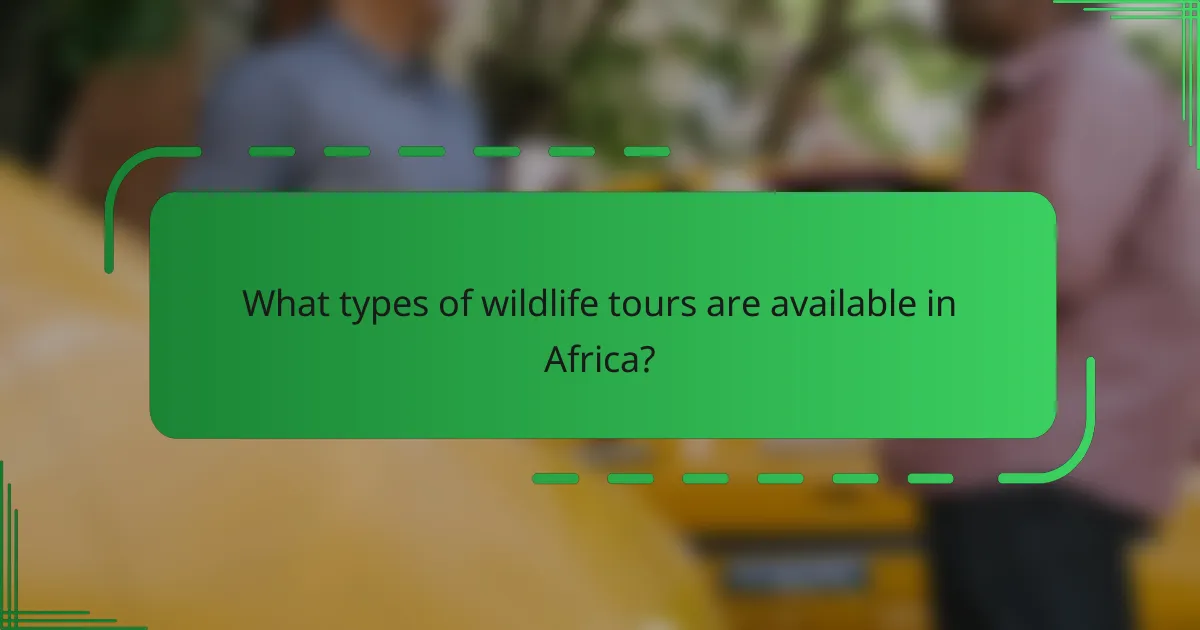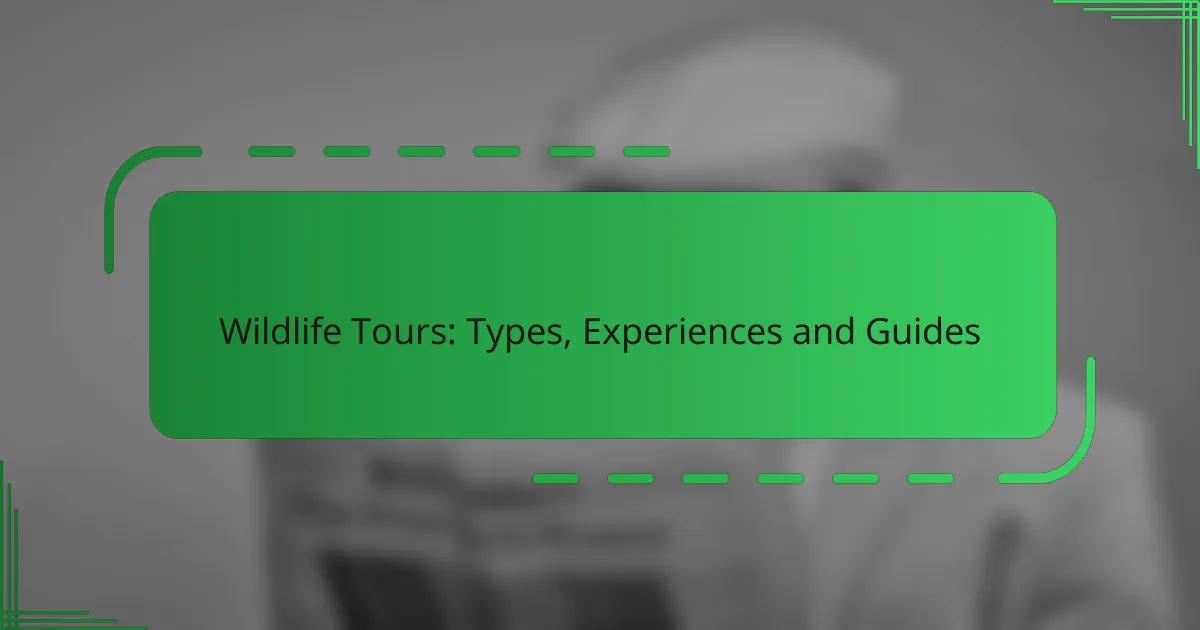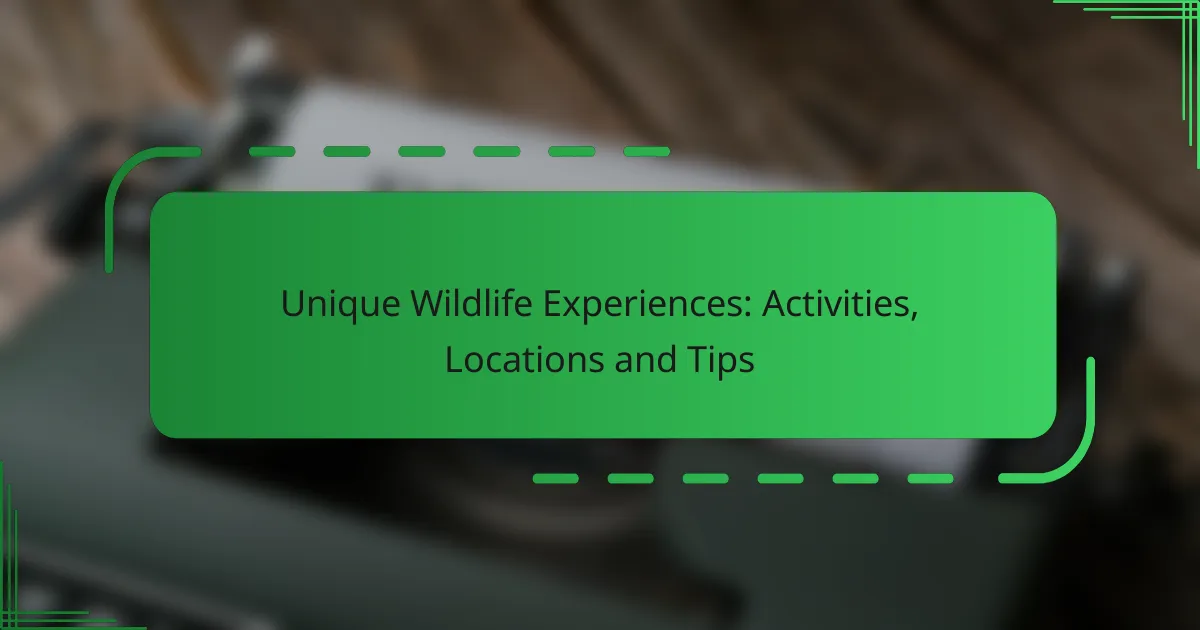Wildlife tours provide an exciting opportunity to explore the natural world and observe animals in their habitats. From thrilling safaris in Africa to serene birdwatching and marine explorations, these tours cater to diverse interests and offer unique experiences. Selecting a knowledgeable guide can significantly enhance your adventure, ensuring both safety and a deeper understanding of wildlife and ecosystems.

What types of wildlife tours are available in Africa?
Africa offers a diverse range of wildlife tours that cater to various interests, including safaris, birdwatching, marine wildlife exploration, photography, and conservation efforts. Each type of tour provides unique experiences, allowing travelers to engage with the continent’s rich biodiversity in different ways.
Safari tours
Safari tours are perhaps the most iconic wildlife experiences in Africa, focusing on observing large mammals in their natural habitats. These tours can vary from luxury lodges to budget camping options, with durations ranging from a few days to several weeks.
When planning a safari, consider the best time to visit, which often aligns with the dry season for optimal wildlife viewing. Popular destinations include the Serengeti in Tanzania and Kruger National Park in South Africa.
Birdwatching tours
Birdwatching tours in Africa attract enthusiasts eager to spot a variety of avian species, including endemic and migratory birds. These tours often take place in national parks and reserves known for their rich birdlife, such as the Okavango Delta in Botswana.
Travelers should bring binoculars and field guides to enhance their experience. The best seasons for birdwatching typically coincide with the rainy season when many species are nesting and more active.
Marine wildlife tours
Marine wildlife tours focus on exploring Africa’s coastal regions and oceans, offering opportunities to see dolphins, whales, and various fish species. Popular locations for these tours include the waters off the coast of South Africa and Mozambique.
These tours can include activities like snorkeling and diving, which allow for close encounters with marine life. Travelers should check for seasonal migrations to maximize their chances of sightings.
Photography tours
Photography tours cater to both amateur and professional photographers looking to capture Africa’s stunning wildlife and landscapes. These tours often provide expert guides who know the best locations and times for optimal lighting and animal activity.
Participants should consider their equipment needs and may benefit from workshops that focus on specific techniques for wildlife photography. The tours can range from short excursions to extensive trips across multiple regions.
Conservation tours
Conservation tours offer travelers a chance to engage in wildlife protection efforts while learning about the challenges facing various species. These tours often involve hands-on activities, such as habitat restoration or anti-poaching initiatives.
Travelers interested in making a positive impact should research organizations that operate these tours, ensuring they align with ethical practices and contribute to local communities. These experiences can be deeply rewarding and educational, providing a unique perspective on wildlife conservation in Africa.

What experiences can you expect on wildlife tours?
Wildlife tours offer immersive experiences that allow you to observe animals in their natural habitats. These tours often include various activities designed to enhance your understanding of wildlife and their ecosystems.
Close encounters with animals
Close encounters with animals provide thrilling opportunities to observe wildlife up close. This can include guided safaris, boat tours, or even walking tours where you may see animals like elephants, lions, or bears in their natural settings.
When participating in these experiences, it’s essential to follow safety guidelines and respect the animals’ space. Always listen to your guide, as they will instruct you on how to interact safely with wildlife.
Guided nature walks
Guided nature walks are a fantastic way to explore diverse ecosystems while learning about local flora and fauna. These walks are typically led by knowledgeable guides who share insights about the environment, animal behavior, and conservation efforts.
Expect to walk varying distances, often ranging from a few kilometers to several hours, depending on the tour. Wear appropriate footwear and bring water to stay hydrated during these excursions.
Camping in the wild
Camping in the wild allows you to fully immerse yourself in nature, often providing a unique chance to experience wildlife at night. Many tours offer camping options that include tents or more comfortable setups, allowing you to enjoy the sounds and sights of the wilderness.
When camping, be prepared for basic amenities and follow guidelines for food storage to avoid attracting animals. This experience often enhances your connection with nature and can be a memorable part of your wildlife tour.
Luxury lodges and accommodations
Luxury lodges and accommodations provide a more comfortable way to experience wildlife tours without sacrificing the adventure. These lodges often feature stunning views, gourmet dining, and guided tours, allowing you to relax after a day of exploration.
While prices can vary significantly, expect to pay a premium for these accommodations, often starting from several hundred to over a thousand USD per night. Booking in advance is advisable, especially during peak seasons, to secure your preferred lodging.

How to choose the best wildlife tour guide?
Choosing the best wildlife tour guide involves assessing their qualifications, reading reviews, and evaluating their communication skills. A knowledgeable and experienced guide can greatly enhance your wildlife experience, ensuring safety and enriching your understanding of the environment.
Check qualifications and experience
Start by verifying the guide’s qualifications, such as certifications in wildlife management or ecology. Experienced guides often have years of fieldwork, which can significantly impact the quality of your tour.
Look for guides who are familiar with local wildlife and ecosystems. For example, a guide specializing in African safaris should have extensive knowledge of the region’s animals and habitats.
Read reviews and testimonials
Reading reviews from previous clients can provide insight into a guide’s reliability and expertise. Check platforms like TripAdvisor or Google Reviews for honest feedback.
Pay attention to comments about the guide’s ability to spot wildlife, share interesting facts, and create a safe environment. High ratings and positive testimonials often indicate a guide who is well-regarded in the industry.
Evaluate communication skills
Effective communication is crucial for a successful wildlife tour. A good guide should be able to convey information clearly and engage participants with interesting stories and facts.
During initial conversations or inquiries, assess how well the guide listens and responds to your questions. A guide who communicates effectively can enhance your overall experience by making it more interactive and informative.

What are the costs associated with wildlife tours?
The costs of wildlife tours can vary significantly based on factors such as location, duration, and included services. Typically, travelers should anticipate spending anywhere from a few hundred to several thousand dollars, depending on the experience they choose.
Average price ranges
Wildlife tour prices generally range from around $200 to $5,000 or more per person. Budget tours may offer basic experiences for lower prices, while luxury options, including private guides and exclusive accommodations, can reach the higher end of the spectrum. For example, a guided safari in Africa might cost between $1,500 and $3,000 for a week-long experience.
Inclusions and exclusions
When evaluating wildlife tour costs, it’s crucial to understand what is included in the price. Many tours cover transportation, accommodations, meals, and guided activities, while others may charge extra for park entrance fees, equipment rentals, or specific excursions. Always check the itinerary and terms to avoid unexpected expenses.
Common exclusions can include personal expenses, gratuities, and travel insurance. Be sure to factor these into your overall budget to ensure a comprehensive understanding of the total costs involved.
Seasonal pricing variations
Wildlife tour prices often fluctuate based on the season, with peak times typically being more expensive. For instance, tours during migration seasons or holidays may see increased rates due to higher demand. Conversely, off-peak seasons can offer significant discounts, making them an attractive option for budget-conscious travelers.
It’s advisable to book in advance during peak seasons to secure better rates and availability. Additionally, consider flexible travel dates to take advantage of lower prices during less popular times of the year.

What are the environmental impacts of wildlife tours?
Wildlife tours can have significant environmental impacts, both positive and negative. While they can promote conservation efforts and raise awareness, they may also lead to habitat disruption, pollution, and stress on animal populations.
Positive impacts of wildlife tours
Wildlife tours can contribute to conservation by generating funds for protected areas and local communities. Tourists often pay entrance fees, which can be used for habitat preservation and species protection. Additionally, these tours can foster a greater appreciation for nature, encouraging visitors to support conservation initiatives.
Engaging local communities in wildlife tourism can create economic incentives to protect wildlife. When communities benefit financially from preserving their natural resources, they are more likely to engage in sustainable practices that protect habitats and biodiversity.
Negative impacts of wildlife tours
On the downside, wildlife tours can lead to habitat degradation, especially in sensitive ecosystems. Increased foot traffic can compact soil, damage vegetation, and disturb wildlife. Additionally, noise and pollution from tour vehicles can disrupt animal behaviors and breeding patterns.
Overcrowding in popular wildlife viewing areas can also create stress for animals, leading to changes in their natural behaviors. This can result in decreased reproductive success and increased mortality rates in some species. Tour operators must be mindful of group sizes and the timing of visits to minimize these impacts.
Mitigation strategies for wildlife tours
To mitigate negative impacts, tour operators should follow established guidelines and best practices for wildlife tourism. This includes limiting group sizes, maintaining a safe distance from animals, and adhering to designated paths to minimize habitat disturbance.
Educating tourists about responsible wildlife viewing can also help reduce negative effects. Tourists should be informed about the importance of not feeding animals, keeping noise levels down, and respecting wildlife habitats. Implementing these strategies can enhance the sustainability of wildlife tours and protect the environments they showcase.



